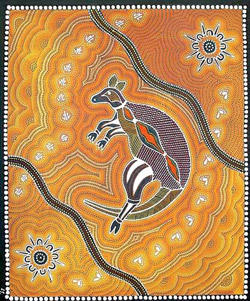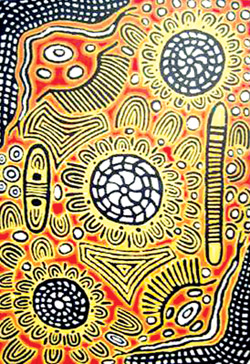|
Tracing the Australian Aboriginal drawings from
history:
Alluring art
Madhubhashini Rathnayaka
The world’s largest island and s mallest continent, Australia, is a
land of vast contrast. The people with dark chocolate colour skins; the
Aborigines knew how to survive in this harsh climate.
All occupied parts of Australia, adapting incredibly to the harshness
of the desert interior by digging small wells and memorising their
locations, along with other natural waterholes, through folklore and
ritual. They learned how to make long, straight spears by digging out
straight roots hidden deep in the ground, reaching out from low desert
shrubs as they could not find significant trees in these desert areas.
|
Tracing the roots
|
| With the use
of stone tool technology and painting, Australia’s Aboriginal
culture probably represents the oldest surviving culture in the
world; which means until 1960s the Australian Aboriginal
practised most ancient stone tool technology practised by
humans. The rock art tradition, mainly as paintings in rock
shelters and as engravings on exposed rocks, has continued to
the present. Even the body decoration and accouterments those
worn in ceremonies to this day are painted similarly in rock
shelters in northern Australia again revealing the great age of
Aboriginal culture. |
The arts great paintings, lengthy songs and dances (corroborates)
accompanied by stories that continue for days like great operas- strict
law and order and religion are some main features of the Aboriginal
culture. Then how can we say that they did not have elements of
civilized culture though they did not build large stone monuments, did
not farm animals and did not cultivate the soil for crops?
As a result of the harsh living conditions the aborigines were
nomadic and had to keep moving from place to place to allow them to find
enough food to survive.
|

Kangaroo is a common sight in the Australian landscapes.
Pictures: onlineaustralia.org and kunama.com |
|

Naturalistic art style on rock |
|

A circle might represent any important person or place |
With the Rainbow Serpent mythology recorded in rock shelter paintings
believed to be 7,000 years old in the Kakadu National Park region and
ancient rock art which shows many arts and Ancestral Beings (deities or
gods) prove that Australia’s Aborigines belongs the longest continuing
religion in the world. Rock art became the way to record Aboriginal
culture as they did not have a formal written language. At the same time
their history was passed down orally and also through songs and dances.
Aboriginal have a belief of the creation period that important
ancestral beings formed the land and created the people, plants and
animals; which is referred to as the ‘Dreamtime’. Much of Aboriginal art
relates to stories of the Dreamtime. To teach the people their laws and
ceremonies these ancestral beings are often depicted via the art with
human, animal, plant or combined forms. There is an enormous variety o f
Aboriginal art. Each region has its own particular style
Traditional Aboriginal art is carried out using primitive methods
because of the nomadic lifestyle simple tools like the chewed end of a
twig was used as a brush. Colour was held in the mouth and sprayed over
a hand held on a rock; the painting style was simple dot paintings or
x-ray style. In ‘X-ray’ art mainly the internal anatomy of an animal is
drawn. Feathers, blood other natural items were used, depending on where
the people lived. Some of the most beautiful Australian Aboriginal art
using a naturalistic art style is found in the rock art across northern
Australia. Many Aborigines living in many regions today still live a
part traditional life so have the laws of their ancient culture and
still practice their traditional art form.
The art style of each region has been passed down through the
generations. Each mark is symbolic. For an instance an a arc shape might
represent a man or woman sitting at their campfire, or it may represent
a boomerang. A circle might represent any important person or place, or
even represent the story of important event that took place. Dot
Painting Style is also a special kind of art inherited by Aborigines.
The use of dots was once particularly seen on body decoration also can
be seen among Aboriginal especially in their ceremonies.
There are designs and decorations which are applied to the bodies and
especially constructed head dresses of actors: to secret-sacred ritual
objects that are stored near the ceremonial grounds; and often to
shields, boomerangs and other weapons which are not, alone considered
dangerous. But in a ceremonial situation they sing the correct
secret-sacred chants. Then they are believed to partake of mythological
forces. Thus, the dancers and the objects they use are thought to become
imbued with supernatural power. Only initiated men are allowed to take
part in these ceremonies. Women have their own traditional ceremonies.
With the influence of the white settlers the lifestyle of the
Aboriginal changed. Brutal massacres and the introduction of diseases,
alcohol etc. ccccc racked their culture. Over the generations the
Aboriginal have adapted to the white man’s culture but in many remote
communities traditional culture is still carried out. The wider art
world has discovered Aboriginal art and today traditional Aboriginal art
is much sort after by art lovers around the world.
It commands a high price and many primitive artist of today are
earning large amounts of money for their art. Naturally the colours the
artists use today are not the original colours but large range of
colours. Then questions arise. With this modern version of traditional
art will the traditional arts disappear? Or do we have to make use of
those traditional arts in order to broaden the margins of arts? |



